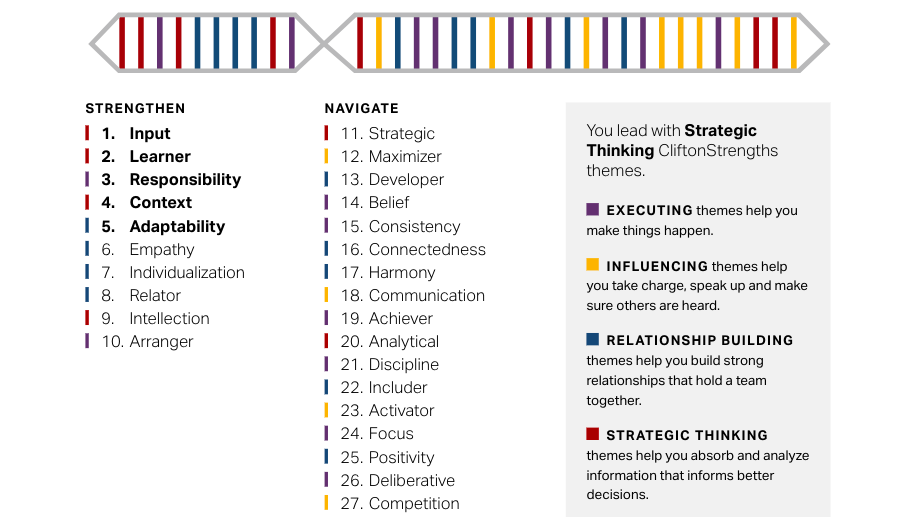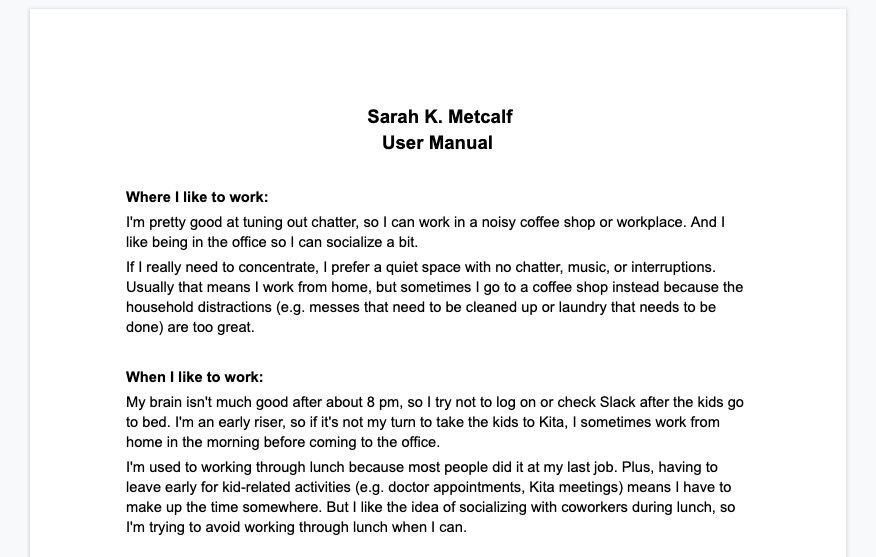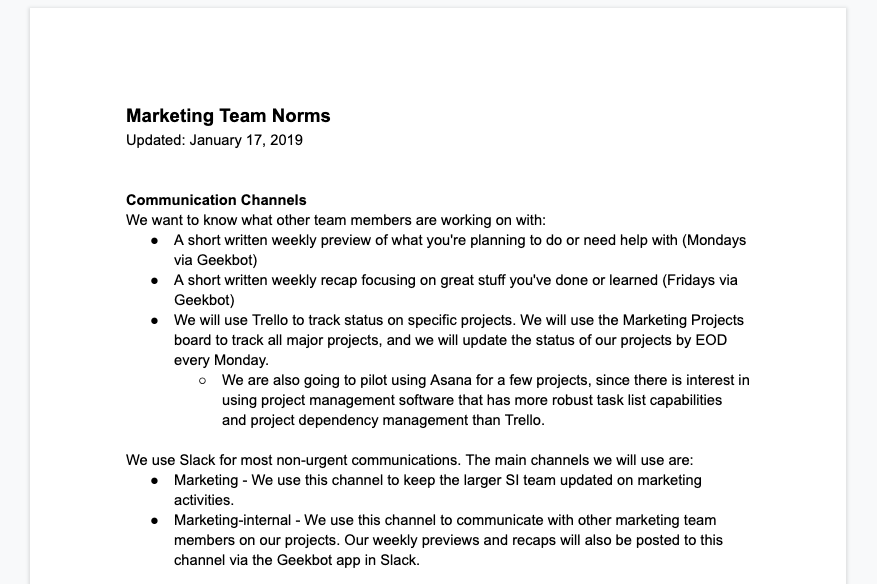In this article:
- Prepare, then share
- Identify (and appreciate) everyone’s strengths
- Understand how everyone approaches collaborative work
- Provide your operating instructions to your colleagues
- Navigate individual work preferences to create team norms
- Decide what you want to accomplish, together
- Set it, but don’t forget it
When I joined Small Improvements as Director of Marketing in 2018, it quickly became clear to me that we had some work to do to create a collaborative, high-performing team. Two members of the team were brand new, and the other two members complained about having few opportunities to work together – something both of them craved. Unfortunately, this lack of interaction had also created a lack of alignment and trust between them.
To help us all get on the same page and working as a team, I blocked our calendars for a day so we could have a team-building offsite. But instead of scheduling a visit to a ropes course or a cooking class, I created a workshop focused on the following goals:
- Learn more about each other, including our strengths, interaction styles, and work preferences.
- Discuss and agree to a set of team norms that will guide how we work together and help us be more effective as a team.
- Talk about how we want to set goals for the team and identify our priorities for the quarter.
Prepare, then share
Reflecting on one’s strengths and work preferences can be hard to do on the spot, so I asked team members to complete a few assignments before we met:
First, take the CliftonStrengths assessment to identify and learn more about your strengths. Please take this online test when you have some time and bring the results with you to the workshop so we can share them with each other.
Second, create your own “user manual” to let us know your individual preferences when it comes to work and life. I came up with a simple template for the manual – please create a duplicate copy for yourself and then start writing! I included sections that I think we’d all be interested in hearing about, but feel free to add, delete, or otherwise make it yours.
Lastly, please create your own Marketing Team Wish List. What are the things you’d like to the marketing team do, both in terms of output and how we work? To focus on the things you think are most important, let’s do just five items for output and five items for how we work.
This pre-work took longer than all of us expected, mostly because creating our user manuals required quite a bit of thought. We each probably spent about 2-3 hours on the pre-work, and most of that was spent on the user manual.
Then it was finally time to get together and talk about ourselves.
Identify (and appreciate) everyone’s strengths
My husband had taken the CliftonStrengths assessment from Gallup with his team and recommended it to me. I liked how it focused on the talents that each person brings to the table. I could see where it might be useful, not only for helping each of us understand what we naturally do best, but also to see how each member can contribute to the team’s success. It could also show us where we might have gaps and challenges as a team.
Each strength fits into one of four domains: Strategic Thinking (S), Execution (E), Influencing (I), and Relationship Building (R). While Gallup recommends focusing on the top five strengths, we actually found it useful to look at the other strengths in the top ten as well. (There are a total of 34 strengths evaluated by the assessment.)

A few things jumped out about these results when looking at our team as a whole. One, we had an abundance of Influencing and Relationship Building strengths in our top 5 lists, which makes sense given our role in communicating our value proposition to prospective buyers and current customers. And two, our team was somewhat lighter on Executing strengths, so we’d probably have to push each other to complete the projects we start.
As a manager, I have found it very useful to know each team member’s CliftonStrengths. Not only can I direct them to work that utilizes their strengths, but I can also remind them to watch out for the blind spots they are likely to have.
Understand how everyone approaches collaborative work
I first learned about Linda Berens’ Interaction Styles as part of a manager training workshop, and I found it immensely helpful for understanding how I tend to approach work. I also liked that it didn’t require a long assessment questionnaire – the workshop facilitator just read descriptions of the four styles out loud, and I immediately knew which one I was. My Behind-the-Scenes style explained both my focus on producing high-quality work and my desire to gather input and feedback. And that, in turn, indicated why I might need to push myself to release “imperfect” work.
Below is a short summary of the four Interaction Styles, taken from the website of the Linda Berens Institute:
- Behind-the-Scenes: Places a high value on high-quality work informed by inputs from diverse sources.
- Chart-the-Course: Places a high value on having a plan to complete a project and keeping it on track.
- In-Charge: Places a high value on executing and seeing results quickly.
- Get-Things-Going: Places a high value in involving and influencing people in decision-making.
Each of these Interaction Styles have different preferences for directing or informing communications, initiating versus responding roles, and an outcome versus process focus.
When we reviewed these Interaction Styles as a group, we discovered that I and one other team member prefer to give “informing” feedback that highlights problems but doesn’t stipulate a specific solution. We don’t want to tell folks what to do so they have the freedom to choose the solution they think works best. But it turned out that two other team members much prefer “directing” feedback that proposes a specific solution. Rather than going through another round or two of feedback to tease out a solution that everyone could agree upon, they’d rather know right up front what you’d suggest and why.
This key difference had led to a great deal of frustration in the past. Now that we had discussed our preferences for informing or directing communication, we should be able to collaborate more effectively.
Provide your operating instructions to your colleagues
After sharing our strengths and interaction styles, we pulled up the user manuals we had created to talk about our work and communication preferences. The template I created for the team had the following sections:
- Where I like to work
- When I like to work
- How I like to communicate
- How I like to give and receive feedback
- What I’m good at
- What I struggle with
- Things I enjoy
- Things I avoid
- Other things to know about me

We began discussing our manuals section by section, sharing our own preferences first, and then talking about what that meant in terms of how we work as a team. This sharing really helped each of us get to know individual work habits better.
One team member, for instance, told us that she doesn’t really check Trello regularly and gets a ton of email, so tagging her on a Trello card won’t catch her attention. “Just send me a Slack message,” she requested. Now we were better equipped to get her feedback quickly and knew to look into ways to link Trello with Slack to see if that would streamline communications.
In addition to learning about our colleagues’ work habits, discussing the user manuals also helped us reflect further on our own preferences, strengths, and challenges. There were several times when someone stated a preference, and then another person would say, “Oh, I do that, too!”
Navigate individual work preferences to create team norms
As we discussed the user guides during the team offsite, I started taking notes on some of the decisions we were making about how we should work together as a team. This document became our team norms, a living set of guidelines that we all agreed to try to follow.

Some sections of the user manuals were more helpful for creating team norms than others. The first four sections described work habits and were the most helpful for discussing how we should work together. The last five sections revealed more about the kinds of work we like and don’t like to do. We found these sections harder to write because they required more reflection. We also didn’t spend as much time discussing those sections as we did the first four. It was good information for us to share with each other, but we could have just shared it in writing – we didn’t necessarily need to discuss it aloud.
Decide what you want to accomplish, together
At the end of the day, we took a little time to start talking about our priorities as a team. We each shared the “wish lists” we had created before the workshop. These lists contained the top five things we each wanted the team to do in terms of output (e.g. specific experiments or campaigns), and the top five things we wanted the team to do in terms of how we worked together.
We discussed all of the wish list items briefly, but we ran out of time to narrow down the lists to a focused set of goals for the quarter. Truthfully, by that time it was late in the day, and we were pretty tired, so the discussion probably wouldn’t have been very productive anyway. But thanks to our discussions during the team-building offsite, I was able to propose four quarterly goals to the team the following week, and we decided to adopt three of them in a matter of minutes.
Set it, but don’t forget it
We didn’t finish putting together our team norms or identifying our quarterly team goals at the team offsite, but we did make very good starts on both of these. And, more importantly, we got to know each other much better. It can feel hard to justify taking time out of “productive” work to share and reflect on who we are as people and how we want to work as a team. But it really has made a big difference in how well we work together and how much everyone enjoys their work.
We made a number of changes to our processes through the team norms, and, not surprisingly, some have been more successful than others. That’s why we periodically make time to review how they are working and make adjustments. If a process isn’t working well, we evaluate whether it needs to be changed. Sometimes it does, and other times we just need to be more disciplined and hold each other accountable. The good news is that even if there are problems, we trust our ability to solve it together.



